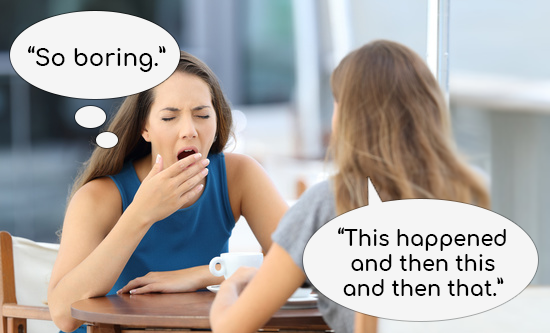Two coworkers met during break time and shared the interesting things that happened to them so far. One worked through his story in a linear fashion, i.e., from point A to point B. The other started with, “You won’t believe what happened to me today…”
Which story would be more fascinating? Which would engage you more?
What Makes a Story Interesting?
First of all, a good story talks about a topic that’s interesting or important to the audience such as adding value to the topic, according to the American Press Institute. So the no.1 consideration when writing story-based lessons should be: “What’s In It For My Audience (WIIFMA)?”
After that are these three things: emotions, embellishment and authenticity, according to sales leadership expert Lisa McLeod.
A boring story is like Wikipedia. It provides the listener or learner with the facts: “This happened and then this and then that.” Boring stories give the same focus to every minute detail.

Great stories, on the other hand, provide interpretation of the facts, highlighting some details over others. By drawing attention to these important parts, great stories supply meaning to an event.

How to Exaggerate Your Story-Based Lessons
A potent method of attracting learners’ attention is exaggeration. It guides them to the important message or critical learning point in story-based lessons.

Here’s how writer and visual artist Annie Weatherwax incorporates exaggeration in her writing:
| 1. |
Decide on your message or lesson. “When I write a scene, I distort reality as a painter does. I decide first how I want my world to be understood. What is it that I want my readers to feel and see clearly?” |
|
| 2. |
Pick elements to highlight or emphasize. “Then I’ll look around at my setting and ask myself: What’s here that I can use? If there is light coming in the room, I’ll accentuate it to set the mood. If there’s a couch, I might heighten my readers awareness of how it’s worn.” |
|
| 3. |
Choose character traits to magnify. “And I will study my characters’ faces. Is there a specific feature I can exaggerate to make the reader understand who they are more clearly? And how can I dramatize or embellish what my characters do and say?” |
|
| 4. |
Rinse and repeat, as necessary. “I will pick and choose and manipulate the essential elements of my scene until I’ve reshaped reality into a new form, one that holds together and sheds an unexpected light.” |
Exaggeration is a storytelling tool, so use it well. Our story-based lessons should definitely inspire learners to act and change.
References
American Press Institute. What makes a good story?Cheryl Conner. Thought Leadership: What Makes a Good Story?.
Forbes, Feb. 23, 2016 Assessing Authenticity Quotient in Story-based eLearning Design
Lisa Earle McLeod. Why Exaggerating Your Stories Is Good for Everyone, Mostly.
Huffington Post, June 18, 2014 “Why Exaggeration Works in Learning” John Penturn on Quora
Annie Weatherwax. Exaggeration & Distortion: What Writers Can Learn From Visual Artists.
Ploughshares at Emerson College Tip #41 – How to Weave Hard Facts and Emotions into your eLearning Lessons Tip #201 – How Visual Arts Inspire Microlearning Lessons
Ray Jimenez, PhD
Vignettes Learning
“Helping Learners Learn Their Way”

